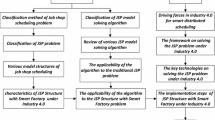Abstract
Making a high quality staff schedule is both difficult and time consuming for any company that has employees working on irregular schedules. We formulate a mixed integer program (MIP) to find a feasible schedule that satisfies all hard constraints while minimizing the soft constraint violations as well as satisfying as many of the employees’ requests as possible. We present the MIP model and show the result from four real world companies and institutions. We also compare the results with those of a local search based algorithm that is designed to emulate the solution strategies when the schedules are created manually. The results show that using near-optimal solutions from the MIP model, with a relative MIP gap of around 0.01–0.1, instead of finding the optimal solution, allows us to find very good solutions in a reasonable amount of time that compare favorably with both the manual solutions and the solutions found by the local search based algorithm.





Similar content being viewed by others
References
Ahmad, J., Yamamoto, M., & Ohuchi, A. (2000). Evolutionary algorithms for nurse scheduling problem. In Proceedings of CEC00 (pp. 196–203). San Diego
Aickelin, U., & Dowsland, K. (2000). Exploiting problem structure in a genetic algorithm approach to a nurse rostering problem. Journal of Scheduling, 3(3), 139–153.
Alfares, H. K. (2004). Survey, categorization and comparison of recent tour scheduling literature. Annals of Operations Research, 127, 145–175.
Alsheddy, A., & Edward, T. (2011). Empowerment scheduling for a field workforce. Journal of Scheduling, 217, 1–16.
Al-Yakoob, S. M., & Sherali, H. D. (2008). A column generation approach for an employee scheduling problem with multiple shifts and work locations. Journal of the Operational Research Society, 59(1), 34–43.
Ásgeirsson, E. I. (2012). Bridging the gap between self schedules and feasible schedules in staff scheduling. Annals of Operations Research. doi:10.1007/s10479-012-1060-2
Ásgeirsson, E.I., Kyngäs, J., Nurmi, K. & Stølevik, M. (2011). A Framework for Implementation-Oriented Staff Scheduling. In Proceedings of the 5th Multidisciplinary International Scheduling Conference: Theory and Applications (MISTA), Phoenix.
Ásgeirsson, E. I., & Siguroardóttir, G. L. (2012). Near-optimal MIP solutions for preference based self-scheduling. In Proceedings of the 9th International Conference on the Practice and Theory of Automated Timetabling (PATAT), pp. 222–241.
Bailyn, L., Collins, R., & Song, Y. (2007). Self-scheduling for hospital nurses: an attempt and its difficulties. Journal of Nursing Management, 15(1), 72–77.
Bard, J. F., & Purnomo, H. W. (2005). Preference scheduling for nurses using column generation. European Journal of Operational Research, 164, 510–534.
Bartholdi, J. J. (1981). A guaranteed-accuracy round-off algorithm for cyclic scheduling and set covering. Operations Research, 29, 501–510.
Brusco, M. J., & Jacobs, L. W. (1995). Cost analysis of alternative formulations for personnel scheduling in continuously operating organisations. European Journal of Operational Research, 86, 249–261.
Burke, E. K., & De Causmaecker, P. (1999). A hybrid tabu search algorithm for the nurse rostering problem. SEAL’98, LNCS, 1585, 187–194.
Burke, E. K., De Causmaecker, P., Petrovic, S., & Vanden Berghe, G. (2004). Variable neighborhood search for nurse rostering problems. Metaheuristics, 8, 153–172.
Burke, E. K., De Causmaecker, P., & Van Landeghem, H. (2004). The state of the art of nurse rostering. Journal of Scheduling, 7, 441–499.
Datasets for experimental results: http://www.ru.is/kennarar/eyjo/staffscheduling.html.
De Causmaecker, P., & Vanden Berghe, G. (2011). Towards a reference model for timetabling and rostering. Annals of Operations Research, 155(1), 289–309.
De Causmaecker, P., & Vanden Berghe, G. (2011). A categorisation of nurse rostering problems. Journal of Scheduling, 14, 3–16.
Dowsland, K. (1998). Nurse scheduling with tabu search and strategic oscillation. European Journal of Operations Research, 106, 393–407.
Easton, F., & Mansour, N. (1993). A distributed genetic algorithm for employee staffing and scheduling problems. In: Conference on Genetic Algorithms San Mateo, pp. 360–367.
Ernst, A. T., Jiang, H., Krishnamoorthy, M., Owens, B., & Sier, D. (2004). An annotated bibliography of personnel scheduling and rostering. Annals of Operations Research, 127, 21–144.
Ernst, A. T., Jiang, H., Krishnamoorthy, M., & Sier, D. (2004). Timetabling and rostering. European Journal of Operational Research, 153(1), 3–27.
Garey, M. R., & Johnson, D. S. (1979). Computers and Intractability. A Guide to the Theory of NP-Completeness: Freeman.
Hung, R. (1992). Improving productivity and quality through workforce scheduling. Industrial Management, 34(6), 4.
Jeroen, B., & Demeulemeester, E. (2007). On the trade-off between staff-decomposed and activity-decomposed column generation for a staff scheduling problem. Annals of Operations Research, 155(1), 143–166.
Kellogg, D. L., & Walczak, S. (2007). Nurse scheduling: from academia to implementation or not. Interfaces, 37(4), 355–369.
Lau, H. C. (1996). On the complexity of manpower shift scheduling. Computers and Operations Research, 23(1), 93–102.
Meisels, A., & Schaerf, A. (2003). Modelling and solving employee timetabling problems. Annals of Mathematics and Artificial Intelligence, 39, 41–59.
Rowland, H. S., & Rowland, B. L. (1997). Nursing administration handbook (4th ed.). Gaithersburg, MD: Aspen Publications.
Tanomaru, J. (1995). Staff scheduling by a genetic algorithm with heuristic operators. In: Proceedings of CEC95 (pp. 456–461).
Tien, J., & Kamiyama, A. (1982). On manpower scheduling algorithms. SIAM Review, 24(3), 275–287.
van der Veen E., & Veltman B. (2009). Rostering from staffing levels: A branch-and-price approach. In: Proceedings of the 35th International Conference on Operational Research Applied to Health Services (ORAHS), pp. 1–10.
Author information
Authors and Affiliations
Corresponding author
Additional information
Work done in collaboration with Vaktaskipan ehf.
Rights and permissions
About this article
Cite this article
Ásgeirsson, E.I., Sigurðardóttir, G.L. Near-optimal MIP solutions for preference based self-scheduling. Ann Oper Res 239, 273–293 (2016). https://doi.org/10.1007/s10479-014-1597-3
Published:
Issue Date:
DOI: https://doi.org/10.1007/s10479-014-1597-3




